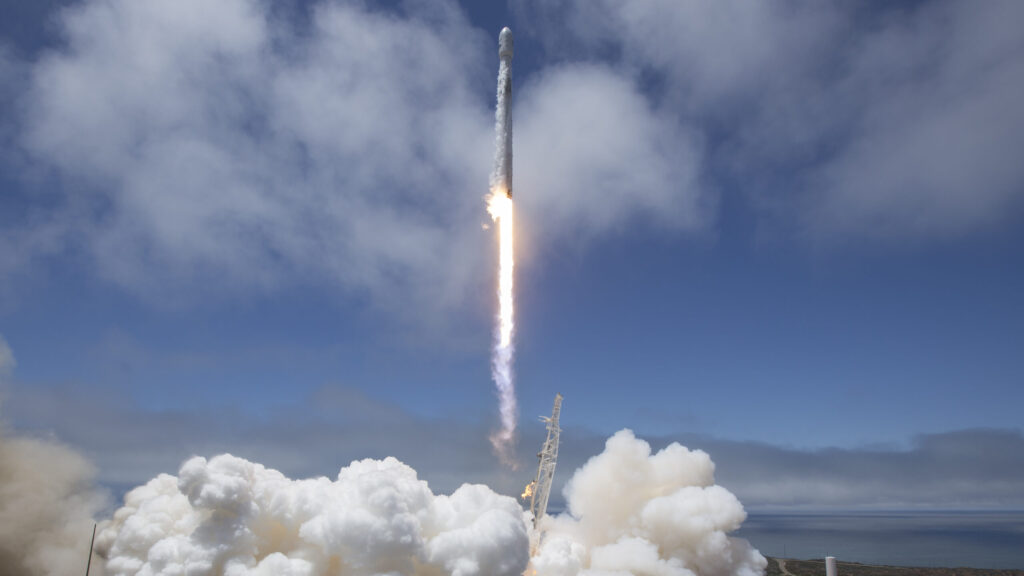
SpaceX Falcon 9 launches from Vandenberg SFB in California. (Photo by Bill Ingalls/NASA via Getty Images)
Editor’s Note 4/03/2023 at 10:30 am: SpaceX successfully launched the SDA payloads on April 2 at 10:29 ET following an abort March 30 that the company attributed to an automatic alarm on the first stage rocket, and a delay of several days to investigate.
WASHINGTON — The inaugural “Tranche 0” Space Development Agency satellites for relaying data and keeping tabs on adversary missiles will launch Thursday if all goes well — in what will be the first substantiation of the Space Force’s long-touted “pivot” towards on-orbit resilience via use of large, low-cost constellations in multiple orbits.
The 10 satellites, which will be lofted on a reusable SpaceX Falcon 9 from Vandenberg SFB to low Earth orbit (LEO), are essentially test satellites, designed to demonstrate the feasibility of the “cost, schedule and scalability” of a “proliferated architecture” to perform “beyond line of sight targeting and advanced missile detection and tracking,” according to an SDA fact sheet provided to reporters.
SDA’s mission is to rapidly, and relatively cheaply, field LEO networks and accompanying ground infrastructure for a number of key Space Force missions, using an incremental approach that will see improved capabilities on orbit every couple of years. This network of networks, newly dubbed the Proliferated Warfighter Space Architecture, includes hundreds of satellites, battle management software, new types of technologies and payloads (for missions such as augmenting GPS) and ground support.
Even before blastoff, the Tranche 0 launch already is showing the feasibility of the rapid development effort, SDA Director Derek Tournear told reporters in a briefing today.
“We’re right at two and a half years from order to orbit,” Tournear said. “So, pretty excited to show that the model actually does work to be able to do that proliferation to get the capabilities to the warfighter at speed.”
The Space Force fiscal 2024 budget request includes $4.7 billion for SDA — a 55 percent increase over last year’s request of $2.6 billion.
Included in Thursday’s launch will be eight satellites for the SDA’s Transport Layer, a high-speed, low-latency, tactical communications network using laser intersatellite links; and two for the Tracking Layer, designed for missile warning and tracking of both ballistic and hypersonic missiles. There will be 28 Tranche 0 satellites in total, with the second lot of 18 planned for launch in June. Each of the birds costs an average of $15 million to build, according to the SDA fact sheet.
Tournear said that the total cost of the Tranche 0 satellite phase, “including all of the Transport satellites, all of the Tracking satellites, all of the ground, all of the launch, and the [operations and maintenance] tail out through the end of fiscal year 2025 is right at $980 million.”
Transport Layer
The Transport Layer network eventually will comprise 300 to 500 satellites in LEO ranging from 750 kilometers to 1,200 kilometers in altitude. These satellites are designed to provide the communications backbone of the Defense Department’s Joint All Domain Command and Control (JADC2) concept for managing operations across the ground, air, sea, space and cyber domains.
Space Force chief Gen. Chance Saltzman said today that the Transport Layer is “one of the most crucial” service contributions to JADC2.
“The ability to move data globally at scale to anybody that needs, it seems like a no brainer that you would have to have that for Joint All Domain Command and Control,” he told an online event sponsored by Defense One.
The agency in July 2020 awarded defense giant Lockheed Martin and relative newcomer York Space Systems contracts to each build a set of 10 satellites for the Tranche 0 Transport Layer: Lockheed Martin’s contract was worth $187.5 million; York’s, $94 million.
The York satellites launching tomorrow will include two variants of the data relay satellites, according to the SDA fact sheet: five “Group A” space vehicles, or “SVAs,” that will carry “two optical communications terminals” each and radio frequency “receive/transmit capability”; and three “Group B” space vehicle satellites that add on “tactical data link (TDL) receive/transmit capability” to the SVA configuration. (SDA previously has explained that the Transport Layer satellites will carry the ubiquitous Link 16 tactical data link, used widely across NATO, to communicate with existing ground-, sea- and air-based platforms.)
Tournear said the Tranche 0 data satellites will participate in upcoming exercises in the Indo-Pacific region, “primarily working with the Marines,” later this year.
SDA is asking for a total of $2.6 billion in FY24 research, development, test and evaluation for the Transport Layer — funds that largely will support development of the follow-on iteration of satellites, called Tranche 1 and expected to provide a first real operational capability. That satellite set will include 128 satellites.
Tracking Layer
The Tracking Layer eventually will consist some 200 satellites — a network confusingly called the Resilient Missile Warning Missile Tracking – Low Earth Orbit program by the Space Force. This effort is one of three separate Space Force programs for developing missile warning/tracking in different orbits, with the other two managed by the service’s main acquisition unit, Space Systems Command.
There will be eight total Tracking Layer satellites in Tranche 0, with SDA contracting in October 2020 with SpaceX, at $149 million, and L3Harris, at $193.5 million, to each build four satellites.
The two SpaceX satellites being launched Thursday will carry a “wide field of view” sensor, according to the SDA fact sheet. SDA’s wide field of view infrared cameras will be used to spot missile launches and track them over a big swath of the Earth’s surface, as well as queue other more precise sensors for targeting.
The following six tracking satellites in Tranche 0 will launch in June. Tournear said the Tranche 0 birds will undertake testing against a hypersonic missile in spring 2024.
SDA is asking for a total of $1.5 billion in FY24 request for the Tracking Layer, also primarily for the next Tranche 1 satellite variants.






















